Management and Business Context: Annotated Bibliography Assignment
VerifiedAdded on 2023/06/08
|8
|2065
|475
Annotated Bibliography
AI Summary
This annotated bibliography examines the critical contextual factors influencing organizational decision-making, as explored through five journal articles. The paper begins with an introduction that highlights the importance of these factors, including organizational structure and governance, environmental forces, risks faced by firms, organizational practices, and the functions of diverse firms. Each article is summarized, defining the central contextual factor, discussing new findings, and explaining the implications for managers. The first article explores the role of governance in hybrid organizations. The second article examines how firms manage environmental forces through innovation. The third article discusses how successful entrepreneurs minimize risks. The fourth article focuses on measuring organizational performance and best practices. The fifth article analyzes the impact of age diversity on organizational performance. The conclusion synthesizes these factors, emphasizing their interconnectedness and their collective impact on achieving organizational goals in a competitive environment. This paper offers valuable insights for managers seeking to navigate the complexities of the modern business landscape.
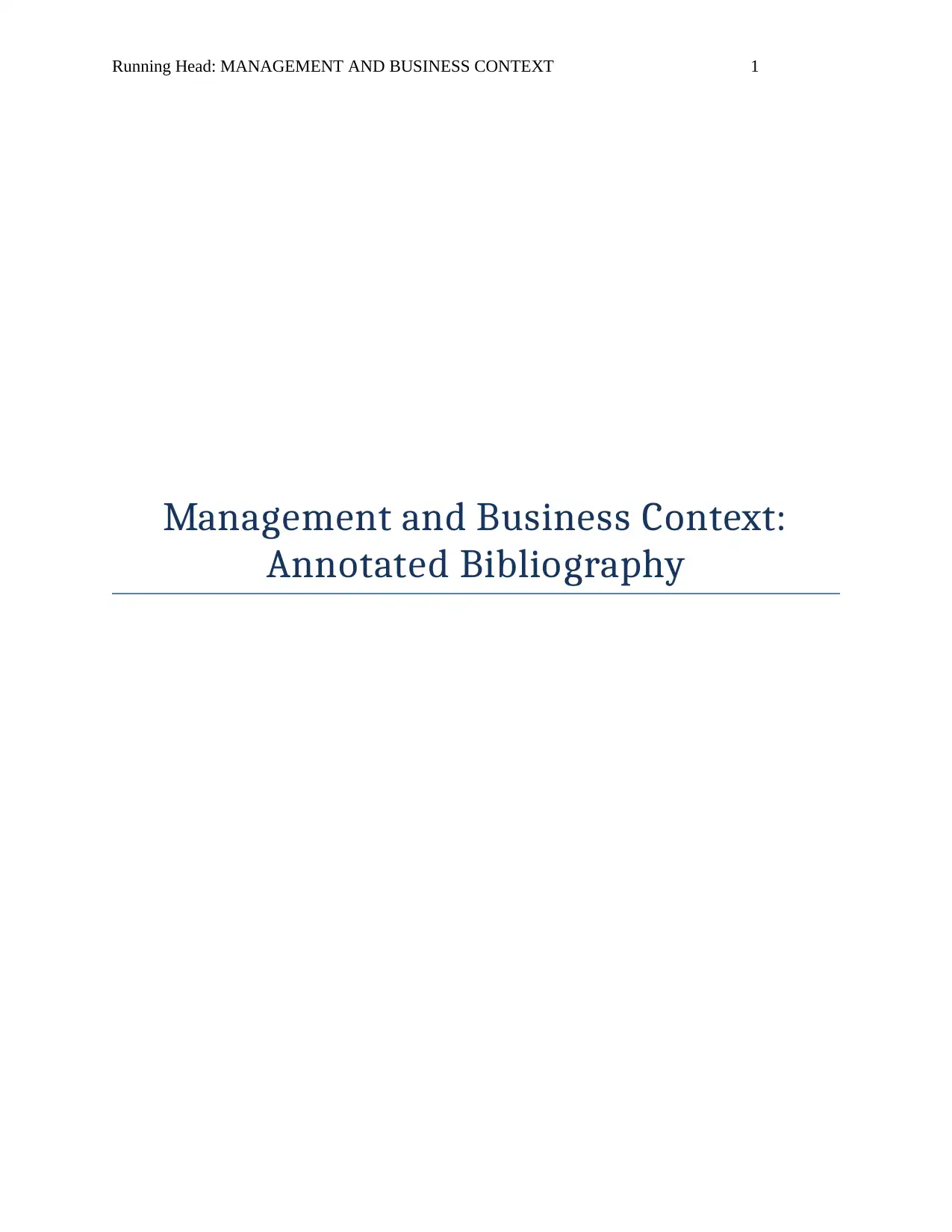
Running Head: MANAGEMENT AND BUSINESS CONTEXT 1
Management and Business Context:
Annotated Bibliography
Management and Business Context:
Annotated Bibliography
Paraphrase This Document
Need a fresh take? Get an instant paraphrase of this document with our AI Paraphraser
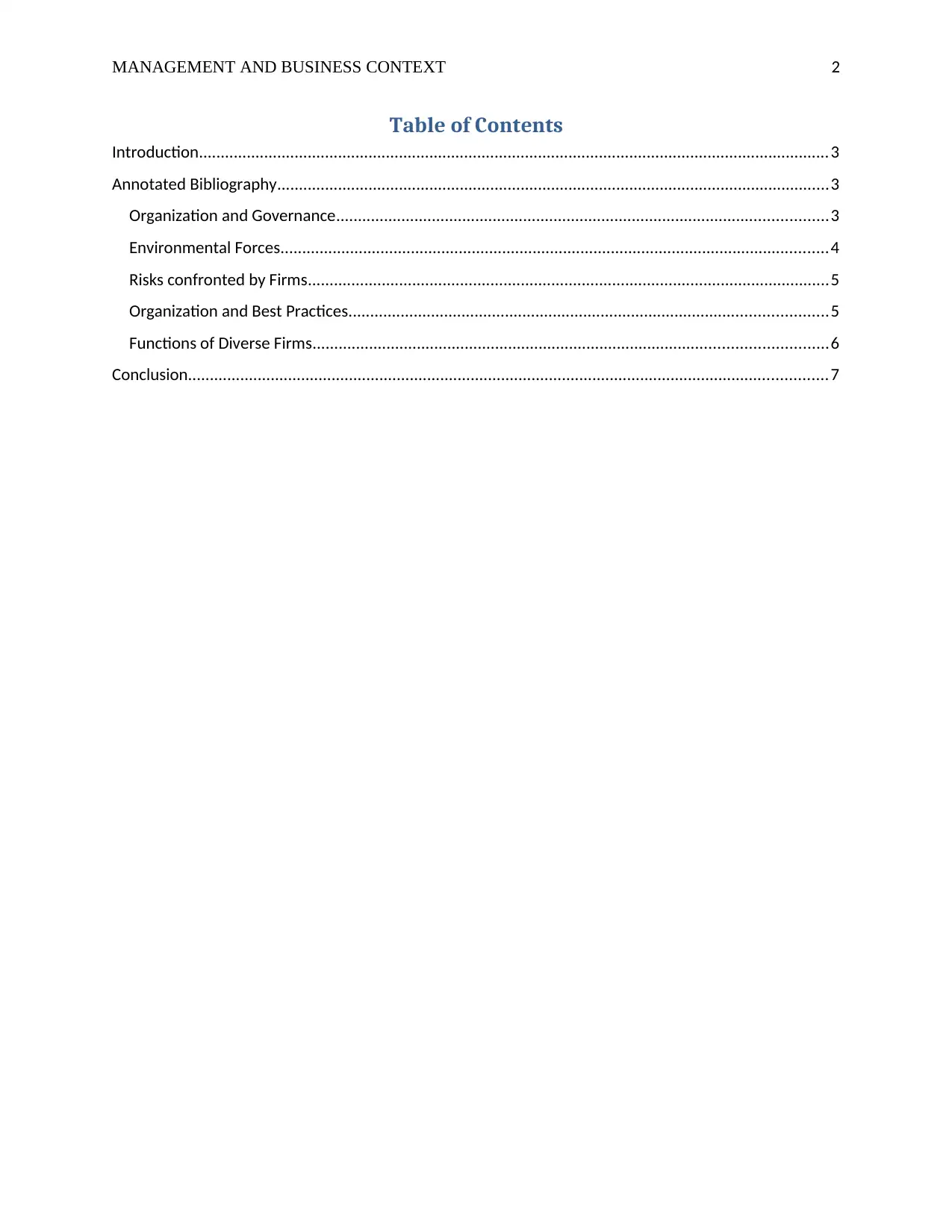
MANAGEMENT AND BUSINESS CONTEXT 2
Table of Contents
Introduction.................................................................................................................................................3
Annotated Bibliography...............................................................................................................................3
Organization and Governance.................................................................................................................3
Environmental Forces..............................................................................................................................4
Risks confronted by Firms........................................................................................................................5
Organization and Best Practices..............................................................................................................5
Functions of Diverse Firms......................................................................................................................6
Conclusion...................................................................................................................................................7
Table of Contents
Introduction.................................................................................................................................................3
Annotated Bibliography...............................................................................................................................3
Organization and Governance.................................................................................................................3
Environmental Forces..............................................................................................................................4
Risks confronted by Firms........................................................................................................................5
Organization and Best Practices..............................................................................................................5
Functions of Diverse Firms......................................................................................................................6
Conclusion...................................................................................................................................................7
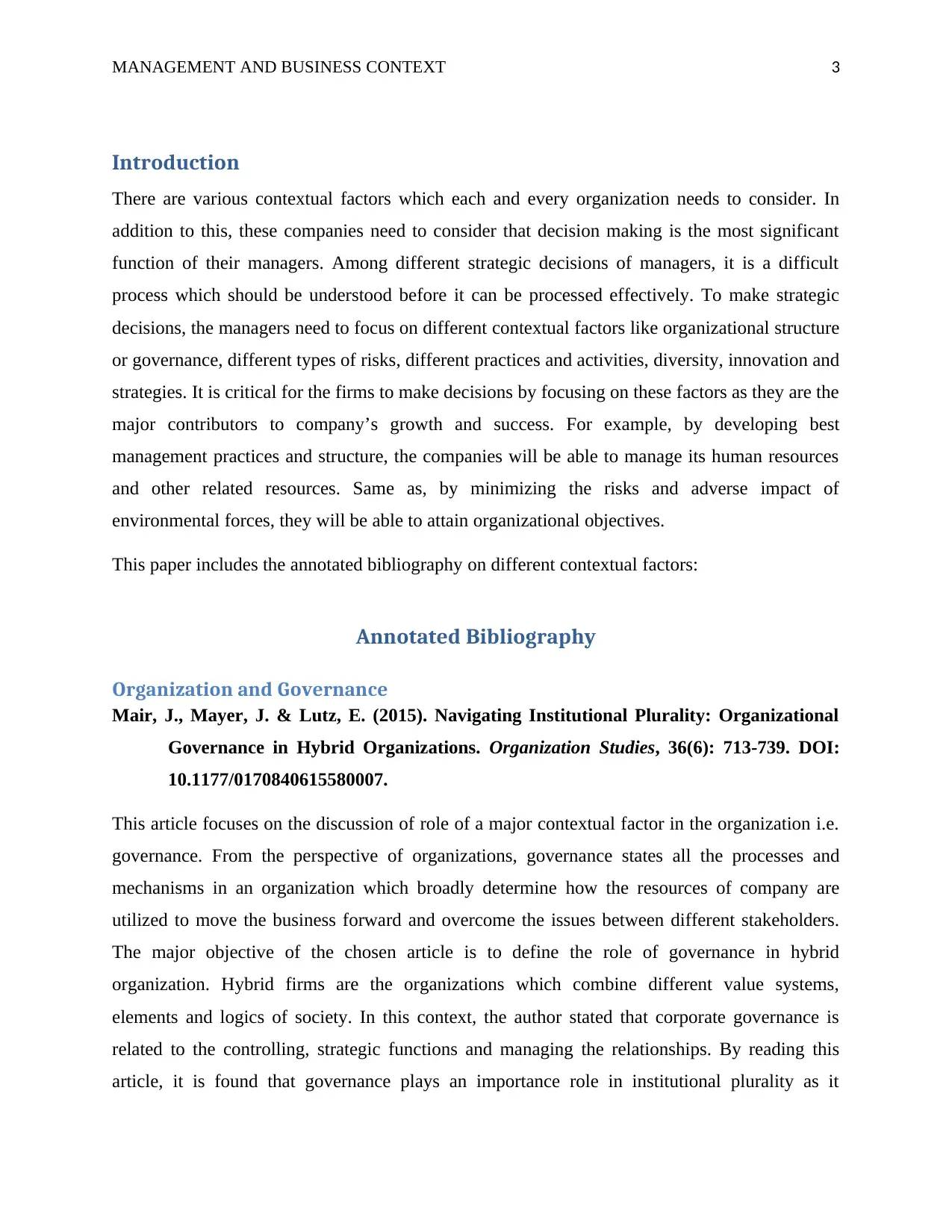
MANAGEMENT AND BUSINESS CONTEXT 3
Introduction
There are various contextual factors which each and every organization needs to consider. In
addition to this, these companies need to consider that decision making is the most significant
function of their managers. Among different strategic decisions of managers, it is a difficult
process which should be understood before it can be processed effectively. To make strategic
decisions, the managers need to focus on different contextual factors like organizational structure
or governance, different types of risks, different practices and activities, diversity, innovation and
strategies. It is critical for the firms to make decisions by focusing on these factors as they are the
major contributors to company’s growth and success. For example, by developing best
management practices and structure, the companies will be able to manage its human resources
and other related resources. Same as, by minimizing the risks and adverse impact of
environmental forces, they will be able to attain organizational objectives.
This paper includes the annotated bibliography on different contextual factors:
Annotated Bibliography
Organization and Governance
Mair, J., Mayer, J. & Lutz, E. (2015). Navigating Institutional Plurality: Organizational
Governance in Hybrid Organizations. Organization Studies, 36(6): 713-739. DOI:
10.1177/0170840615580007.
This article focuses on the discussion of role of a major contextual factor in the organization i.e.
governance. From the perspective of organizations, governance states all the processes and
mechanisms in an organization which broadly determine how the resources of company are
utilized to move the business forward and overcome the issues between different stakeholders.
The major objective of the chosen article is to define the role of governance in hybrid
organization. Hybrid firms are the organizations which combine different value systems,
elements and logics of society. In this context, the author stated that corporate governance is
related to the controlling, strategic functions and managing the relationships. By reading this
article, it is found that governance plays an importance role in institutional plurality as it
Introduction
There are various contextual factors which each and every organization needs to consider. In
addition to this, these companies need to consider that decision making is the most significant
function of their managers. Among different strategic decisions of managers, it is a difficult
process which should be understood before it can be processed effectively. To make strategic
decisions, the managers need to focus on different contextual factors like organizational structure
or governance, different types of risks, different practices and activities, diversity, innovation and
strategies. It is critical for the firms to make decisions by focusing on these factors as they are the
major contributors to company’s growth and success. For example, by developing best
management practices and structure, the companies will be able to manage its human resources
and other related resources. Same as, by minimizing the risks and adverse impact of
environmental forces, they will be able to attain organizational objectives.
This paper includes the annotated bibliography on different contextual factors:
Annotated Bibliography
Organization and Governance
Mair, J., Mayer, J. & Lutz, E. (2015). Navigating Institutional Plurality: Organizational
Governance in Hybrid Organizations. Organization Studies, 36(6): 713-739. DOI:
10.1177/0170840615580007.
This article focuses on the discussion of role of a major contextual factor in the organization i.e.
governance. From the perspective of organizations, governance states all the processes and
mechanisms in an organization which broadly determine how the resources of company are
utilized to move the business forward and overcome the issues between different stakeholders.
The major objective of the chosen article is to define the role of governance in hybrid
organization. Hybrid firms are the organizations which combine different value systems,
elements and logics of society. In this context, the author stated that corporate governance is
related to the controlling, strategic functions and managing the relationships. By reading this
article, it is found that governance plays an importance role in institutional plurality as it
⊘ This is a preview!⊘
Do you want full access?
Subscribe today to unlock all pages.

Trusted by 1+ million students worldwide
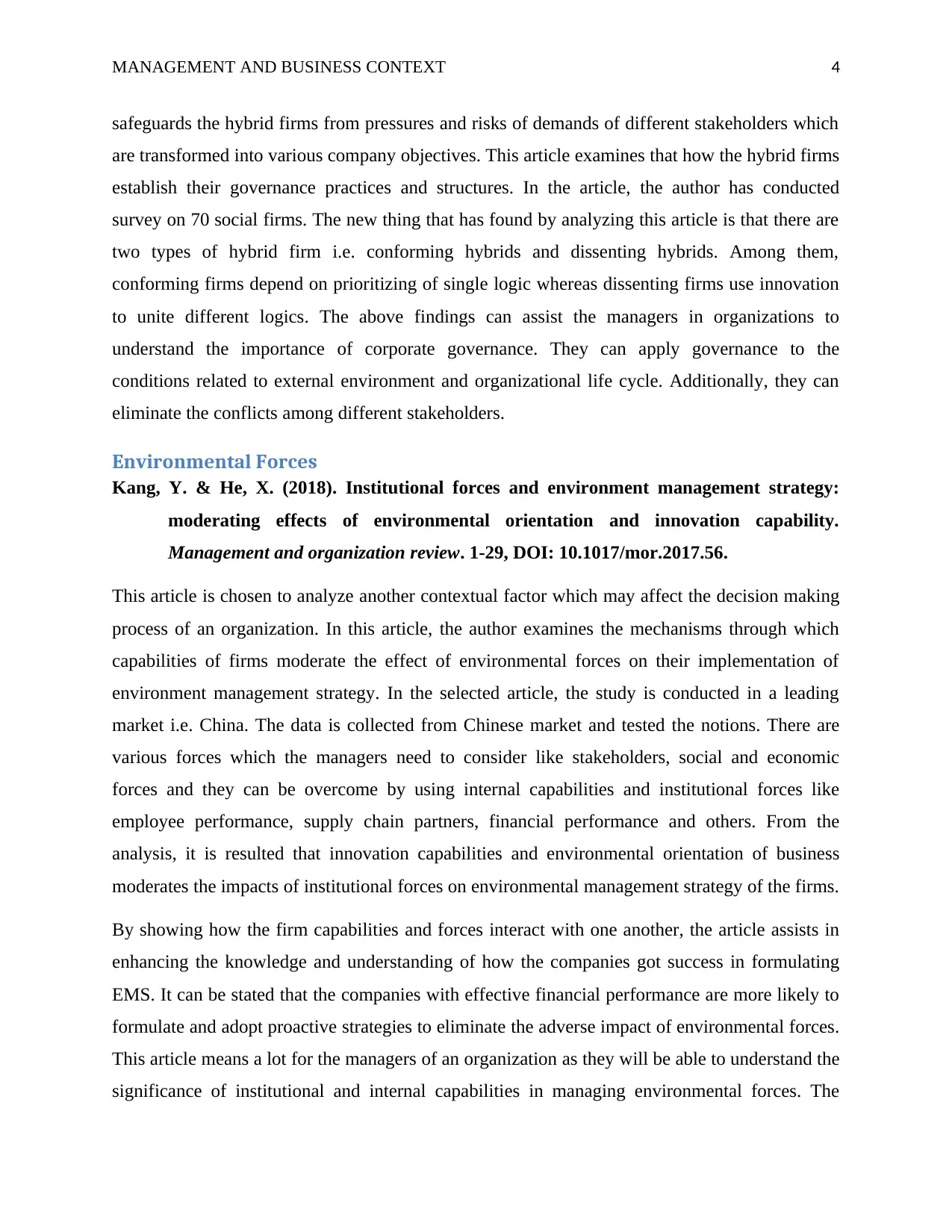
MANAGEMENT AND BUSINESS CONTEXT 4
safeguards the hybrid firms from pressures and risks of demands of different stakeholders which
are transformed into various company objectives. This article examines that how the hybrid firms
establish their governance practices and structures. In the article, the author has conducted
survey on 70 social firms. The new thing that has found by analyzing this article is that there are
two types of hybrid firm i.e. conforming hybrids and dissenting hybrids. Among them,
conforming firms depend on prioritizing of single logic whereas dissenting firms use innovation
to unite different logics. The above findings can assist the managers in organizations to
understand the importance of corporate governance. They can apply governance to the
conditions related to external environment and organizational life cycle. Additionally, they can
eliminate the conflicts among different stakeholders.
Environmental Forces
Kang, Y. & He, X. (2018). Institutional forces and environment management strategy:
moderating effects of environmental orientation and innovation capability.
Management and organization review. 1-29, DOI: 10.1017/mor.2017.56.
This article is chosen to analyze another contextual factor which may affect the decision making
process of an organization. In this article, the author examines the mechanisms through which
capabilities of firms moderate the effect of environmental forces on their implementation of
environment management strategy. In the selected article, the study is conducted in a leading
market i.e. China. The data is collected from Chinese market and tested the notions. There are
various forces which the managers need to consider like stakeholders, social and economic
forces and they can be overcome by using internal capabilities and institutional forces like
employee performance, supply chain partners, financial performance and others. From the
analysis, it is resulted that innovation capabilities and environmental orientation of business
moderates the impacts of institutional forces on environmental management strategy of the firms.
By showing how the firm capabilities and forces interact with one another, the article assists in
enhancing the knowledge and understanding of how the companies got success in formulating
EMS. It can be stated that the companies with effective financial performance are more likely to
formulate and adopt proactive strategies to eliminate the adverse impact of environmental forces.
This article means a lot for the managers of an organization as they will be able to understand the
significance of institutional and internal capabilities in managing environmental forces. The
safeguards the hybrid firms from pressures and risks of demands of different stakeholders which
are transformed into various company objectives. This article examines that how the hybrid firms
establish their governance practices and structures. In the article, the author has conducted
survey on 70 social firms. The new thing that has found by analyzing this article is that there are
two types of hybrid firm i.e. conforming hybrids and dissenting hybrids. Among them,
conforming firms depend on prioritizing of single logic whereas dissenting firms use innovation
to unite different logics. The above findings can assist the managers in organizations to
understand the importance of corporate governance. They can apply governance to the
conditions related to external environment and organizational life cycle. Additionally, they can
eliminate the conflicts among different stakeholders.
Environmental Forces
Kang, Y. & He, X. (2018). Institutional forces and environment management strategy:
moderating effects of environmental orientation and innovation capability.
Management and organization review. 1-29, DOI: 10.1017/mor.2017.56.
This article is chosen to analyze another contextual factor which may affect the decision making
process of an organization. In this article, the author examines the mechanisms through which
capabilities of firms moderate the effect of environmental forces on their implementation of
environment management strategy. In the selected article, the study is conducted in a leading
market i.e. China. The data is collected from Chinese market and tested the notions. There are
various forces which the managers need to consider like stakeholders, social and economic
forces and they can be overcome by using internal capabilities and institutional forces like
employee performance, supply chain partners, financial performance and others. From the
analysis, it is resulted that innovation capabilities and environmental orientation of business
moderates the impacts of institutional forces on environmental management strategy of the firms.
By showing how the firm capabilities and forces interact with one another, the article assists in
enhancing the knowledge and understanding of how the companies got success in formulating
EMS. It can be stated that the companies with effective financial performance are more likely to
formulate and adopt proactive strategies to eliminate the adverse impact of environmental forces.
This article means a lot for the managers of an organization as they will be able to understand the
significance of institutional and internal capabilities in managing environmental forces. The
Paraphrase This Document
Need a fresh take? Get an instant paraphrase of this document with our AI Paraphraser
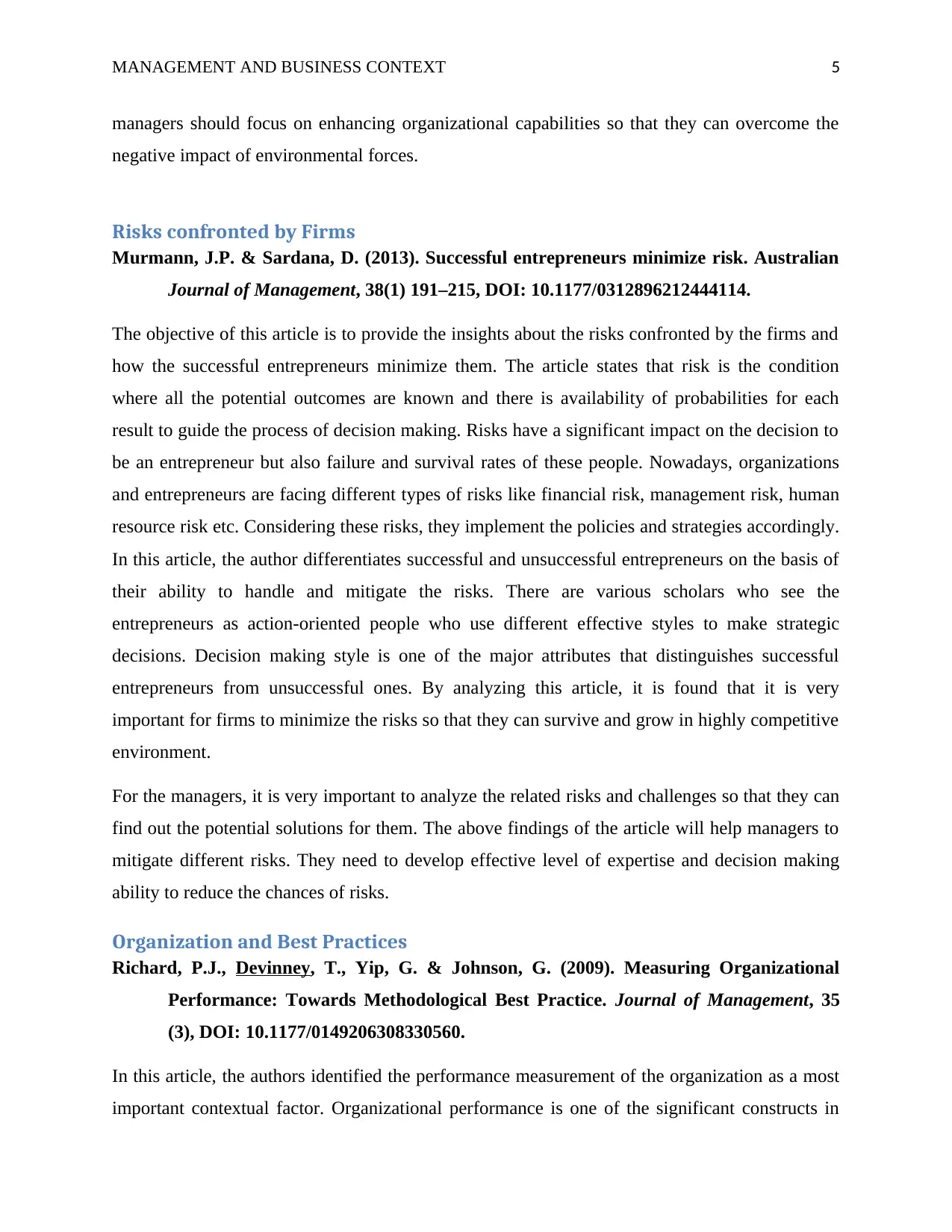
MANAGEMENT AND BUSINESS CONTEXT 5
managers should focus on enhancing organizational capabilities so that they can overcome the
negative impact of environmental forces.
Risks confronted by Firms
Murmann, J.P. & Sardana, D. (2013). Successful entrepreneurs minimize risk. Australian
Journal of Management, 38(1) 191–215, DOI: 10.1177/0312896212444114.
The objective of this article is to provide the insights about the risks confronted by the firms and
how the successful entrepreneurs minimize them. The article states that risk is the condition
where all the potential outcomes are known and there is availability of probabilities for each
result to guide the process of decision making. Risks have a significant impact on the decision to
be an entrepreneur but also failure and survival rates of these people. Nowadays, organizations
and entrepreneurs are facing different types of risks like financial risk, management risk, human
resource risk etc. Considering these risks, they implement the policies and strategies accordingly.
In this article, the author differentiates successful and unsuccessful entrepreneurs on the basis of
their ability to handle and mitigate the risks. There are various scholars who see the
entrepreneurs as action-oriented people who use different effective styles to make strategic
decisions. Decision making style is one of the major attributes that distinguishes successful
entrepreneurs from unsuccessful ones. By analyzing this article, it is found that it is very
important for firms to minimize the risks so that they can survive and grow in highly competitive
environment.
For the managers, it is very important to analyze the related risks and challenges so that they can
find out the potential solutions for them. The above findings of the article will help managers to
mitigate different risks. They need to develop effective level of expertise and decision making
ability to reduce the chances of risks.
Organization and Best Practices
Richard, P.J., Devinney, T., Yip, G. & Johnson, G. (2009). Measuring Organizational
Performance: Towards Methodological Best Practice. Journal of Management, 35
(3), DOI: 10.1177/0149206308330560.
In this article, the authors identified the performance measurement of the organization as a most
important contextual factor. Organizational performance is one of the significant constructs in
managers should focus on enhancing organizational capabilities so that they can overcome the
negative impact of environmental forces.
Risks confronted by Firms
Murmann, J.P. & Sardana, D. (2013). Successful entrepreneurs minimize risk. Australian
Journal of Management, 38(1) 191–215, DOI: 10.1177/0312896212444114.
The objective of this article is to provide the insights about the risks confronted by the firms and
how the successful entrepreneurs minimize them. The article states that risk is the condition
where all the potential outcomes are known and there is availability of probabilities for each
result to guide the process of decision making. Risks have a significant impact on the decision to
be an entrepreneur but also failure and survival rates of these people. Nowadays, organizations
and entrepreneurs are facing different types of risks like financial risk, management risk, human
resource risk etc. Considering these risks, they implement the policies and strategies accordingly.
In this article, the author differentiates successful and unsuccessful entrepreneurs on the basis of
their ability to handle and mitigate the risks. There are various scholars who see the
entrepreneurs as action-oriented people who use different effective styles to make strategic
decisions. Decision making style is one of the major attributes that distinguishes successful
entrepreneurs from unsuccessful ones. By analyzing this article, it is found that it is very
important for firms to minimize the risks so that they can survive and grow in highly competitive
environment.
For the managers, it is very important to analyze the related risks and challenges so that they can
find out the potential solutions for them. The above findings of the article will help managers to
mitigate different risks. They need to develop effective level of expertise and decision making
ability to reduce the chances of risks.
Organization and Best Practices
Richard, P.J., Devinney, T., Yip, G. & Johnson, G. (2009). Measuring Organizational
Performance: Towards Methodological Best Practice. Journal of Management, 35
(3), DOI: 10.1177/0149206308330560.
In this article, the authors identified the performance measurement of the organization as a most
important contextual factor. Organizational performance is one of the significant constructs in
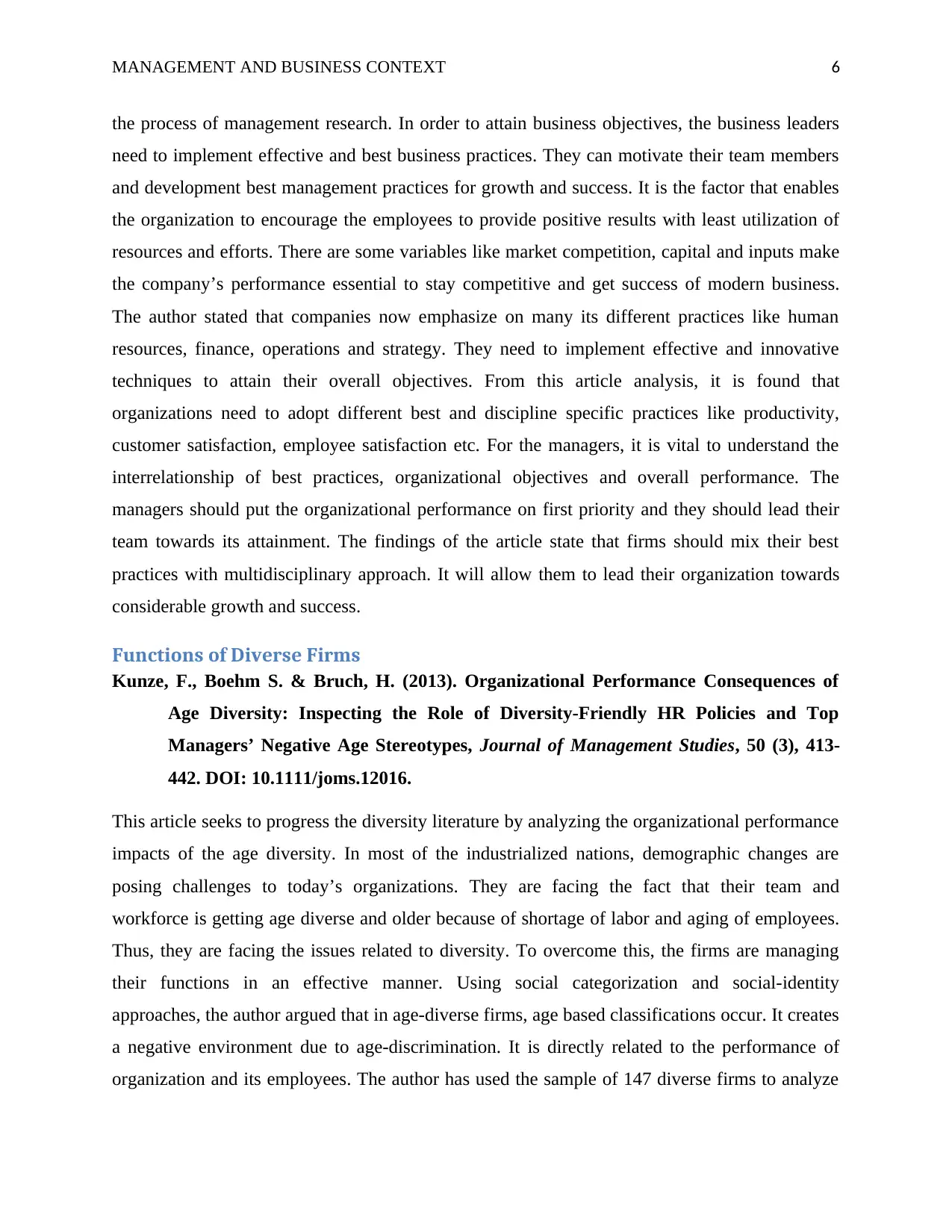
MANAGEMENT AND BUSINESS CONTEXT 6
the process of management research. In order to attain business objectives, the business leaders
need to implement effective and best business practices. They can motivate their team members
and development best management practices for growth and success. It is the factor that enables
the organization to encourage the employees to provide positive results with least utilization of
resources and efforts. There are some variables like market competition, capital and inputs make
the company’s performance essential to stay competitive and get success of modern business.
The author stated that companies now emphasize on many its different practices like human
resources, finance, operations and strategy. They need to implement effective and innovative
techniques to attain their overall objectives. From this article analysis, it is found that
organizations need to adopt different best and discipline specific practices like productivity,
customer satisfaction, employee satisfaction etc. For the managers, it is vital to understand the
interrelationship of best practices, organizational objectives and overall performance. The
managers should put the organizational performance on first priority and they should lead their
team towards its attainment. The findings of the article state that firms should mix their best
practices with multidisciplinary approach. It will allow them to lead their organization towards
considerable growth and success.
Functions of Diverse Firms
Kunze, F., Boehm S. & Bruch, H. (2013). Organizational Performance Consequences of
Age Diversity: Inspecting the Role of Diversity-Friendly HR Policies and Top
Managers’ Negative Age Stereotypes, Journal of Management Studies, 50 (3), 413-
442. DOI: 10.1111/joms.12016.
This article seeks to progress the diversity literature by analyzing the organizational performance
impacts of the age diversity. In most of the industrialized nations, demographic changes are
posing challenges to today’s organizations. They are facing the fact that their team and
workforce is getting age diverse and older because of shortage of labor and aging of employees.
Thus, they are facing the issues related to diversity. To overcome this, the firms are managing
their functions in an effective manner. Using social categorization and social-identity
approaches, the author argued that in age-diverse firms, age based classifications occur. It creates
a negative environment due to age-discrimination. It is directly related to the performance of
organization and its employees. The author has used the sample of 147 diverse firms to analyze
the process of management research. In order to attain business objectives, the business leaders
need to implement effective and best business practices. They can motivate their team members
and development best management practices for growth and success. It is the factor that enables
the organization to encourage the employees to provide positive results with least utilization of
resources and efforts. There are some variables like market competition, capital and inputs make
the company’s performance essential to stay competitive and get success of modern business.
The author stated that companies now emphasize on many its different practices like human
resources, finance, operations and strategy. They need to implement effective and innovative
techniques to attain their overall objectives. From this article analysis, it is found that
organizations need to adopt different best and discipline specific practices like productivity,
customer satisfaction, employee satisfaction etc. For the managers, it is vital to understand the
interrelationship of best practices, organizational objectives and overall performance. The
managers should put the organizational performance on first priority and they should lead their
team towards its attainment. The findings of the article state that firms should mix their best
practices with multidisciplinary approach. It will allow them to lead their organization towards
considerable growth and success.
Functions of Diverse Firms
Kunze, F., Boehm S. & Bruch, H. (2013). Organizational Performance Consequences of
Age Diversity: Inspecting the Role of Diversity-Friendly HR Policies and Top
Managers’ Negative Age Stereotypes, Journal of Management Studies, 50 (3), 413-
442. DOI: 10.1111/joms.12016.
This article seeks to progress the diversity literature by analyzing the organizational performance
impacts of the age diversity. In most of the industrialized nations, demographic changes are
posing challenges to today’s organizations. They are facing the fact that their team and
workforce is getting age diverse and older because of shortage of labor and aging of employees.
Thus, they are facing the issues related to diversity. To overcome this, the firms are managing
their functions in an effective manner. Using social categorization and social-identity
approaches, the author argued that in age-diverse firms, age based classifications occur. It creates
a negative environment due to age-discrimination. It is directly related to the performance of
organization and its employees. The author has used the sample of 147 diverse firms to analyze
⊘ This is a preview!⊘
Do you want full access?
Subscribe today to unlock all pages.

Trusted by 1+ million students worldwide
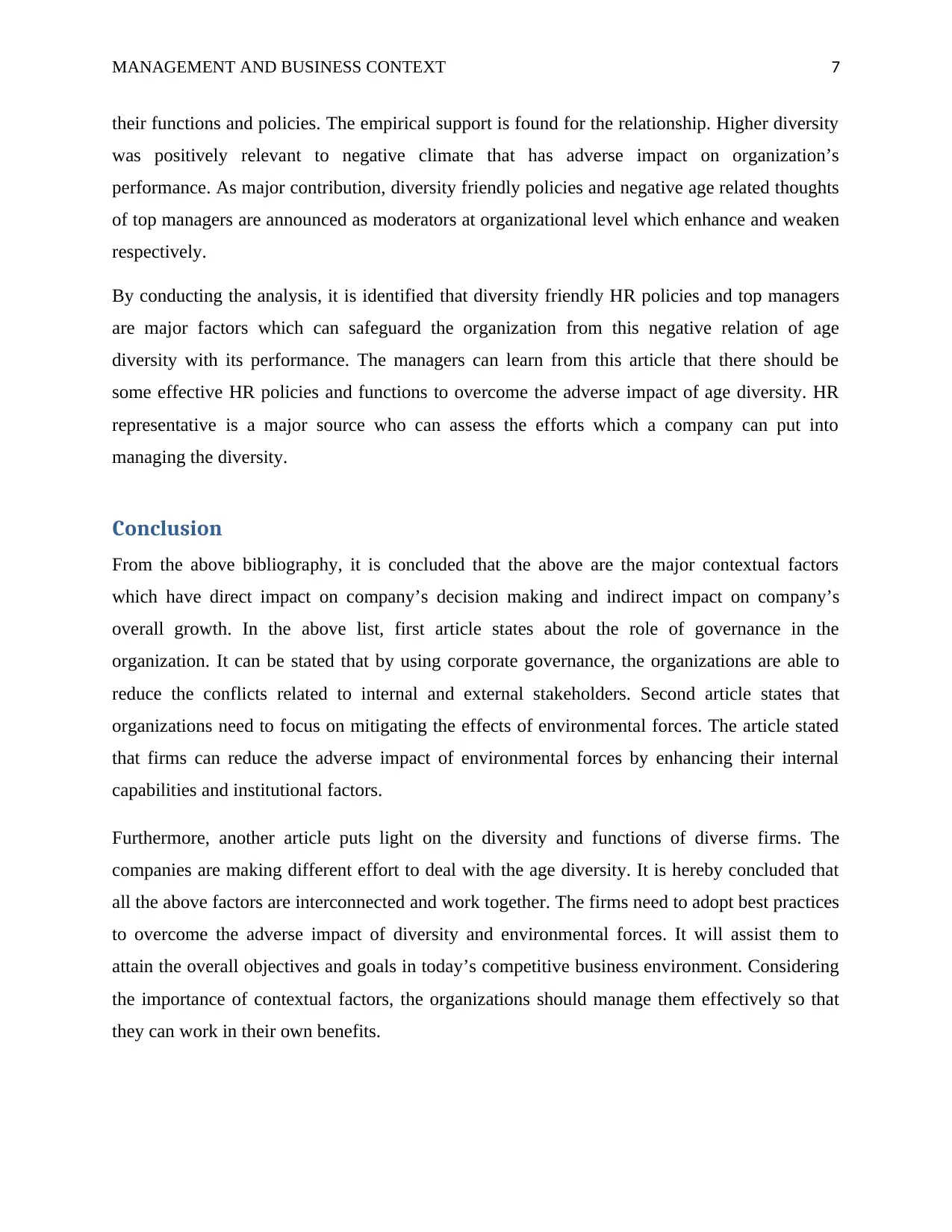
MANAGEMENT AND BUSINESS CONTEXT 7
their functions and policies. The empirical support is found for the relationship. Higher diversity
was positively relevant to negative climate that has adverse impact on organization’s
performance. As major contribution, diversity friendly policies and negative age related thoughts
of top managers are announced as moderators at organizational level which enhance and weaken
respectively.
By conducting the analysis, it is identified that diversity friendly HR policies and top managers
are major factors which can safeguard the organization from this negative relation of age
diversity with its performance. The managers can learn from this article that there should be
some effective HR policies and functions to overcome the adverse impact of age diversity. HR
representative is a major source who can assess the efforts which a company can put into
managing the diversity.
Conclusion
From the above bibliography, it is concluded that the above are the major contextual factors
which have direct impact on company’s decision making and indirect impact on company’s
overall growth. In the above list, first article states about the role of governance in the
organization. It can be stated that by using corporate governance, the organizations are able to
reduce the conflicts related to internal and external stakeholders. Second article states that
organizations need to focus on mitigating the effects of environmental forces. The article stated
that firms can reduce the adverse impact of environmental forces by enhancing their internal
capabilities and institutional factors.
Furthermore, another article puts light on the diversity and functions of diverse firms. The
companies are making different effort to deal with the age diversity. It is hereby concluded that
all the above factors are interconnected and work together. The firms need to adopt best practices
to overcome the adverse impact of diversity and environmental forces. It will assist them to
attain the overall objectives and goals in today’s competitive business environment. Considering
the importance of contextual factors, the organizations should manage them effectively so that
they can work in their own benefits.
their functions and policies. The empirical support is found for the relationship. Higher diversity
was positively relevant to negative climate that has adverse impact on organization’s
performance. As major contribution, diversity friendly policies and negative age related thoughts
of top managers are announced as moderators at organizational level which enhance and weaken
respectively.
By conducting the analysis, it is identified that diversity friendly HR policies and top managers
are major factors which can safeguard the organization from this negative relation of age
diversity with its performance. The managers can learn from this article that there should be
some effective HR policies and functions to overcome the adverse impact of age diversity. HR
representative is a major source who can assess the efforts which a company can put into
managing the diversity.
Conclusion
From the above bibliography, it is concluded that the above are the major contextual factors
which have direct impact on company’s decision making and indirect impact on company’s
overall growth. In the above list, first article states about the role of governance in the
organization. It can be stated that by using corporate governance, the organizations are able to
reduce the conflicts related to internal and external stakeholders. Second article states that
organizations need to focus on mitigating the effects of environmental forces. The article stated
that firms can reduce the adverse impact of environmental forces by enhancing their internal
capabilities and institutional factors.
Furthermore, another article puts light on the diversity and functions of diverse firms. The
companies are making different effort to deal with the age diversity. It is hereby concluded that
all the above factors are interconnected and work together. The firms need to adopt best practices
to overcome the adverse impact of diversity and environmental forces. It will assist them to
attain the overall objectives and goals in today’s competitive business environment. Considering
the importance of contextual factors, the organizations should manage them effectively so that
they can work in their own benefits.
Paraphrase This Document
Need a fresh take? Get an instant paraphrase of this document with our AI Paraphraser

MANAGEMENT AND BUSINESS CONTEXT 8
1 out of 8
Related Documents
Your All-in-One AI-Powered Toolkit for Academic Success.
+13062052269
info@desklib.com
Available 24*7 on WhatsApp / Email
![[object Object]](/_next/static/media/star-bottom.7253800d.svg)
Unlock your academic potential
Copyright © 2020–2025 A2Z Services. All Rights Reserved. Developed and managed by ZUCOL.


